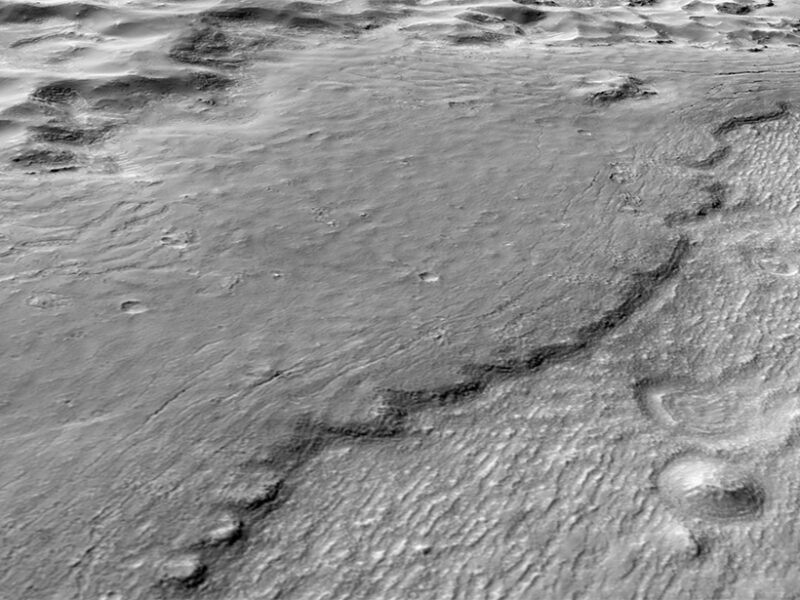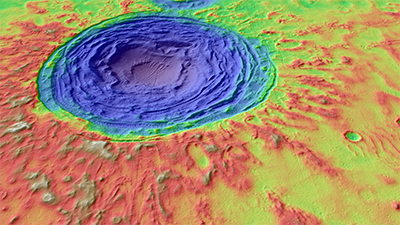
Much of our planet’s recent history is documented in books, letters, photographs, and films. To supplement these human-made records and delve back even further, we rely on nature’s own relics—tree rings, geologic formations, and the evolving genetic makeup of animals—to better understand Earth’s history.
Human exploration of Mars has unfolded in much the same way. By observing the planet through telescopes, studying Martian rocks and meteorites, and collecting data via satellite missions, scientists across many disciplines have been able to piece together some of the natural history of the Red Planet, dating back millions of years.
On the basis of these types of records, scientists believe that at some point, flooding and volcanic activity formed a network of valleys across Mars. Knowing more about the magnitude and timing of these events could reveal more about the planet’s natural history and help identify regions that might be hospitable to microbial life.
Here Hamilton et al. studied a 370-meter-deep, 800-kilometer-long valley—a small subsection of this larger network—called Hrad Vallis. Named after the Armenian word for Mars, Hrad Vallis is young in terms of geologic time; scientists believe it formed during the Amazonian age, or roughly within the past 3 billion years.
 A lava rise pit formed by gradual thickening of lava around an initially high standing topographic obstacle in Hrad Vallis on Mars. Warm colors indicate relatively high elevations, and cool colors represent lower elevations. Credit: University of Arizona, NASA
A lava rise pit formed by gradual thickening of lava around an initially high standing topographic obstacle in Hrad Vallis on Mars. Warm colors indicate relatively high elevations, and cool colors represent lower elevations. Credit: University of Arizona, NASA
Using a combination of mathematical models and geologic mapping, the researchers found that Hrad Vallis was probably formed by an intrusion, underground magma that cools and solidifies before reaching the surface, which triggered a flood of water. This most likely was followed by lava flowing along the surface and forming a flat-topped mound called a lava rise plateau, dotted with small depressions called lava rise pits. This likely was followed by more intrusions and flooding. This pattern of activity—lava flows interspersed with flooding events—has been seen elsewhere on Mars and suggests that other formations from the Amazonian were also born of multistage processes, as opposed to single events.
The researchers also found that some of the lava flows forming Hrad Vallis may have interacted violently with ice deposits at the surface, creating a landscape of depressions, lakes, and sinkholes. This type of landscape, called thermokarst terrain, occurs on Earth in Arctic and sub-Arctic regions when permafrost melts. Amid this lava-ice interaction, it’s possible that a warm, moist environment could have formed, providing a habitat capable of—at least temporarily—sustaining life.
Furthermore, the team found that at least one of the lava flows involved in the formation of Hrad Vallis might have been similar to a smooth, lobate lava called inflated pahoehoe. On Earth, pahoehoe is a common eruption style in which the volume of lava produced per day is quite low, which implies that the Martian eruptions may have lasted for years to decades. If this is true, it would be the best example of such a lava flow found on Mars to date.
These findings not only enrich our understanding of Mars’s past geological transformations but also bring many aspects of its current landscape to light. (Journal of Geophysical Research: Planets, https://doi.org/10.1029/2018JE005543, 2018)
—Sarah Witman, Freelance Writer
The post Tracing the Steps of Hydrothermal Activity in Hrad Vallis, Mars appeared first on Eos.
from Eos https://eos.org/research-spotlights/tracing-the-steps-of-hydrothermal-activity-in-hrad-vallis-mars?utm_source=rss&utm_medium=rss&utm_content=tracing-the-steps-of-hydrothermal-activity-in-hrad-vallis-mars
via IFTTT

